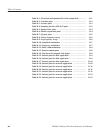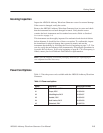
Getting Started
1-2
AWG610 Arbitrary Waveform Generator User Manual
H Five waveform editors (see Table 1–1)
Table 1-1: AWG610 waveform editors
Editor Description
Waveform Creates analog waveform data in graphic or tabular form.
Pattern Creates analog waveform data in timing and table form.
Sequence Creates sequences of waveforms by combining the waveform files
created with the Waveform and/or Pattern Editors.
Text Edits plain ASCIIĆformat waveform files. For example, you can
use the Text editor to edit ASCIIĆformat waveform files that are
read from an external device.
Equation Creates files with equations and compiles them into waveform
files.
H FG mode to generate a standard functional wavefom easyly
The AWG610 Arbitrary Waveform Generator provides the following additional
features:
H An Ethernet port for using the NFS (Network File System) and/or FTP link.
Refer to Ethernet Networking on page 3–155 for information.
H A GPIB interface that can be used for remotely controlling the AWG610
Arbitrary Waveform Generator and for transferring the waveform data from
the external oscilloscopes.
Refer to Connecting to a GPIB Network on page 3–153 for information on
setting the GPIB parameters.
Refer to the AWG500/600 Series Arbitrary Waveform Programmer Manual
for information on the remote control commands.
Refer to Capturing Waveforms on page 3–171 for information about
transferring waveforms from the external oscilloscopes to the AWG610
Arbitrary Waveform Generator.
H A port on the rear panel for connecting a 101- or 106- type keyboard to the
AWG610 Arbitrary Waveform Generator. You can input values or text with
the keyboard instead of using the numeric keypad on the front-panel. Refer
to External Keyboards on page 3–149 for information.
H An adjustment for controlling the CRT brightness. Refer to CRT Brightness
on page 3–151 for information. This setup procedure is also described in
Tutorial 1: Instrument Setup on page 2–49.
Additional Features


















